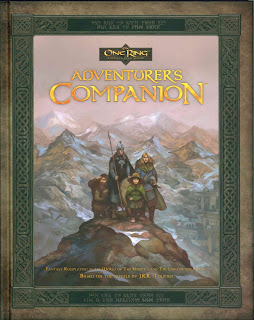That Way Madness Lies...
I am continuing to enjoy my study of The One Ring and its Adventurer's Companion. The Companion brings many of the character culture backgrounds from the various source books allowing one to play Dunlending, Rohirrm, and Dunedain characters, among others. Additional material adds the leader role and some new combat options such as the ability to protect one member of the party by assigning front line characters a guardian role.
Cubicle 7's The One Ring and its 5e associated product, Adventures in Middle-earth take a unique approach to gaming which focusses on certain notable aspects of Professor Tolkien's best known works, The Hobbitt and The Lord Of The Rings trilogy. The One Ring and Adventures in Middle-earth allow players and referee (Lorekeeper) to explore and role-play in the classic fantasy setting, making their own story along the way. The authors of the world's first role-playing game seemed to see very little opportunity in playing in Middle-earth despite the inclusion of hobbits, dwarves and elves, balrogs, ents and nazgul in the game. Inspired by, but not set in the fictional world of Professor Tolkien, the original D&D game is in many ways poorly suited to replicate adventures in Middle-earth and it contains many non-Tolkien elements inspired by the myriad of other sources from which the authors take inspiration.
The One Ring (TOR) offers a game experience very different from D&D. Combat in TOR is stylized and essentially takes a back-seat to the journey and encounter aspects of play. There are many perils to be found in the wilderness and a player character's skill at traveling is just as important, if not more so, as their skill at combat. Use of various player character social skills will often determine the outcome of an encounter with a non-player controlled personality of Middle-earth. In fact encountering a famous character from the novels seems to be a principle draw for playing the TOR role-playing game.
While D&D has roots deeply embedded in the wargaming hobby, TOR seems much less about killing monsters and taking their treasure. In fact, it appears to me the goal of TOR can be found in increasing one's valor and/or wisdom through journeys and encounters while avoiding the worst effects of being exposed to the shadow forces of the dark lord. Combat is a dangerous threat that can serve a narrative purpose, but a focus on killing things seems to miss the point TOR is making, namely that it is fun to travel about Middle-earth, take in the sights and meet a few of the legendary characters from the fiction. Middle-earth, as presented in TOR, is also a dangerous enough place without violence due to fatigue, sickness and hopelessness and ultimately there is the madness that can result from passing contact with shadow and from giving in to one's own dark side.
TOR is not designed to replay The Lord Of The Rings. To repeat a phrase, that story has already been told. It is rather a role-playing game that encourages players to immerse themselves in Professor Tolkien's Middle-earth through the eyes of their characters, to role-play meeting Gandalf or Bilbo Baggins, to look upon the lonely mountain, visit Rivendale and listen to the song of elves. TOR also contains the threat of the shadow which ever lurks in Middle-earth tempting, luring, and corrupting.

No comments:
Post a Comment